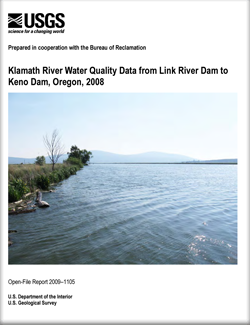 ABSTRACT ABSTRACT
This report documents sampling and analytical methods and presents field data from a second year of an ongoing study on the Klamath River from Link River Dam to Keno Dam in south central Oregon; this dataset will form the basis of a hydrodynamic and water quality model. Water quality was sampled weekly at six mainstem and two tributary sites from early April through early November, 2008. Constituents reported herein include field-measured water-column parameters (water temperature, pH, dissolved oxygen concentration, specific conductance); total nitrogen and phosphorus; particulate carbon and nitrogen; total iron; filtered orthophosphate, nitrite, nitrite plus nitrate, ammonia, organic carbon, and iron; specific UV absorbance at 254 nanometers; chlorophyll a; phytoplankton and zooplankton enumeration and species identification; and bacterial abundance and morphological subgroups. Sampling program results indicated:
- Most nutrient and carbon concentrations were lowest in spring, increased starting in mid-June, remained elevated in the summer, and decreased in fall. Dissolved nitrite plus nitrate had a different seasonal cycle and was below detection or at low concentration in summer.
- Although total nitrogen and total phosphorus concentrations did not show large differences from upstream to downstream, filtered ammonia and orthophosphate concentrations increased in the downstream direction and particulate carbon and particulate nitrogen generally decreased in the downstream direction.
- Large bacterial cells made up most of the bacteria biovolume, though cocci were the most numerous bacteria type. Cocci, with diameters of 0.1 to 0.2 micrometers, were smaller than the filter pore sizes used to separate dissolved from particulate matter.
- Phytoplankton biovolumes were dominated by diatoms in spring and by the blue-green alga Aphanizomenon flos-aquae after mid-June. Another blue-green, Anabaena flos-aquae, was noted in samples from late May to late June. Phytoplankton biovolumes generally were highest at the upstream Link River and Railroad Bridge sites and decreased in the downstream direction.
- Zooplankton densities were largest in late April. Populations were dominated by rotifers and copepods in early spring, and by rotifers and cladocerans in summer, with cladocerans most common at the most upstream site.
|
Part or all of this report is presented in Portable Document Format (PDF); the latest version of Adobe Reader or similar software is required to view it. Download the latest version of Adobe Reader, free of charge. |